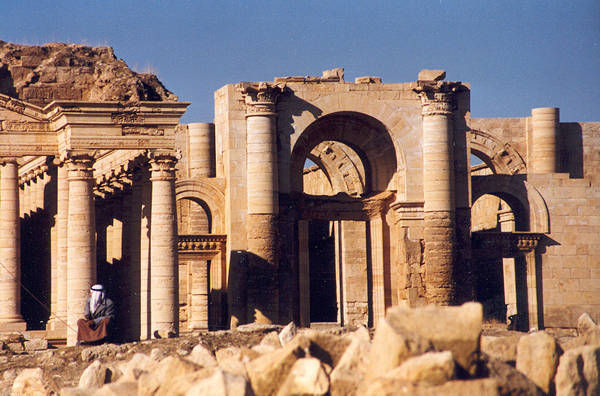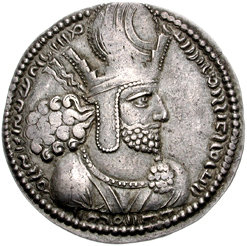al-Nadirah on:
[Wikipedia]
[Google]
[Amazon]
 The medieval story of al-Nadirah is about the fall of Hatra and its princess, who fell in love with the young king Shapur I while he was besieging the city.
This partially fictional narrative is recorded in Persian and Arabic sources of the early Islamic period, and some of its elements inspired some modern stories. Its general theme has common features with some Greek and Roman legends.
The medieval story of al-Nadirah is about the fall of Hatra and its princess, who fell in love with the young king Shapur I while he was besieging the city.
This partially fictional narrative is recorded in Persian and Arabic sources of the early Islamic period, and some of its elements inspired some modern stories. Its general theme has common features with some Greek and Roman legends.
 According to early
According to early
 The medieval story of al-Nadirah is about the fall of Hatra and its princess, who fell in love with the young king Shapur I while he was besieging the city.
This partially fictional narrative is recorded in Persian and Arabic sources of the early Islamic period, and some of its elements inspired some modern stories. Its general theme has common features with some Greek and Roman legends.
The medieval story of al-Nadirah is about the fall of Hatra and its princess, who fell in love with the young king Shapur I while he was besieging the city.
This partially fictional narrative is recorded in Persian and Arabic sources of the early Islamic period, and some of its elements inspired some modern stories. Its general theme has common features with some Greek and Roman legends.
Plot
 According to early
According to early Islamic
Islam (; ar, ۘالِإسلَام, , ) is an Abrahamic monotheistic religion centred primarily around the Quran, a religious text considered by Muslims to be the direct word of God (or '' Allah'') as it was revealed to Muhammad, the ma ...
traditions, al-Nadirah ( ar, النضيرة ''an-Naḍīrah''; fa, نضیره ''Nazirah'') was the daughter of al-Dayzan or Satirun ( Sanatruq II), the king of Araba. She betrayed the fortified capital, Hatra
Hatra ( ar, الحضر; syr, ܚܛܪܐ) was an ancient city in Upper Mesopotamia located in present-day eastern Nineveh Governorate in northern Iraq. The city lies northwest of Baghdad and southwest of Mosul.
Hatra was a strongly fortifi ...
, to the Persian king Shapur I after seeing and falling in love with him while he was besieging the city. She did this by intoxicating her father and the guards of the city gates, or by revealing to the enemy the talisman on which the city's ownership depended. Shapur I captured and destroyed Hatra and killed its king. He departed with al-Nadirah and married her at Ayn al-Tamr. One night al-Nadirah could not sleep, complaining that her bed is too rough for her. It then turned out that a myrtle leaf was stuck in her skin and was irritating her. Astonished by her softness, Shapur I asked her how did her father bring her up, and she described how well he treated her. Shapur I realizes al-Nadirah's ingratitude towards her father and has her executed in a brutal manner.
Sources
The story is mentioned inArabic
Arabic (, ' ; , ' or ) is a Semitic language spoken primarily across the Arab world.Semitic languages: an international handbook / edited by Stefan Weninger; in collaboration with Geoffrey Khan, Michael P. Streck, Janet C. E.Watson; Walter ...
and Persian literature and the poetry of the early Islamic period, including al-Tabari
( ar, أبو جعفر محمد بن جرير بن يزيد الطبري), more commonly known as al-Ṭabarī (), was a Muslim historian and scholar from Amol, Tabaristan. Among the most prominent figures of the Islamic Golden Age, al-Tabari ...
's '' Tarikh al-Tabari'', Mirkhond's '' Rawzat as-Safa''', Ibn Khallikan's ''Wafayāt al-Aʿyān'', and Ferdowsi
, image = Statue of Ferdowsi in Tus, Iran 3 (cropped).jpg
, image_size =
, caption = Statue of Ferdowsi in Tus by Abolhassan Sadighi
, birth_date = 940
, birth_place = Tus, Samanid Empire
, death_date = 1019 or 1025 (87 years old)
, d ...
's '' Shahnama'', where she is recorded as ''Mālikah'' (), daughter of king Tā'ir (), while the Persian king is Shapur II
Shapur II ( pal, 𐭱𐭧𐭯𐭥𐭧𐭥𐭩 ; New Persian: , ''Šāpur'', 309 – 379), also known as Shapur the Great, was the tenth Sasanian King of Kings ( Shahanshah) of Iran. The longest-reigning monarch in Iranian history, he reign ...
, instead of Shapur I.
Analysis
According to Theodor Nöldeke, al-Tabari's story is derived from the Greek tale of Scylla and her father Nisos. Some consider it as a Middle Eastern version of the Tarpeia theme. The theme of Al-Nadirah's legend was used in Hans Christian Andersen's fairy tale "The Princess and the Pea
"The Princess and the Pea" ( da, "Prinsessen paa Ærten"; direct translation: "The Princess on the Pea") is a literary fairy tale by Hans Christian Andersen about a young woman whose royal ancestry is established by a test of her sensitivity. ...
" and Ahmed Shawqi's ''Waraqat al-As'' (''The Myrtle Leaf'').
References
{{reflist Hatra Medieval Arabic literature Shapur I Medieval Arabic poems Love in Arabic literature Legendary Arab people Medieval legends Fictional princesses Middle East in fiction Fictional Iraqi people Islamic fiction Medieval Persian literature Love stories Romance characters Women from the Sasanian Empire Women in pre-Islamic Arabia